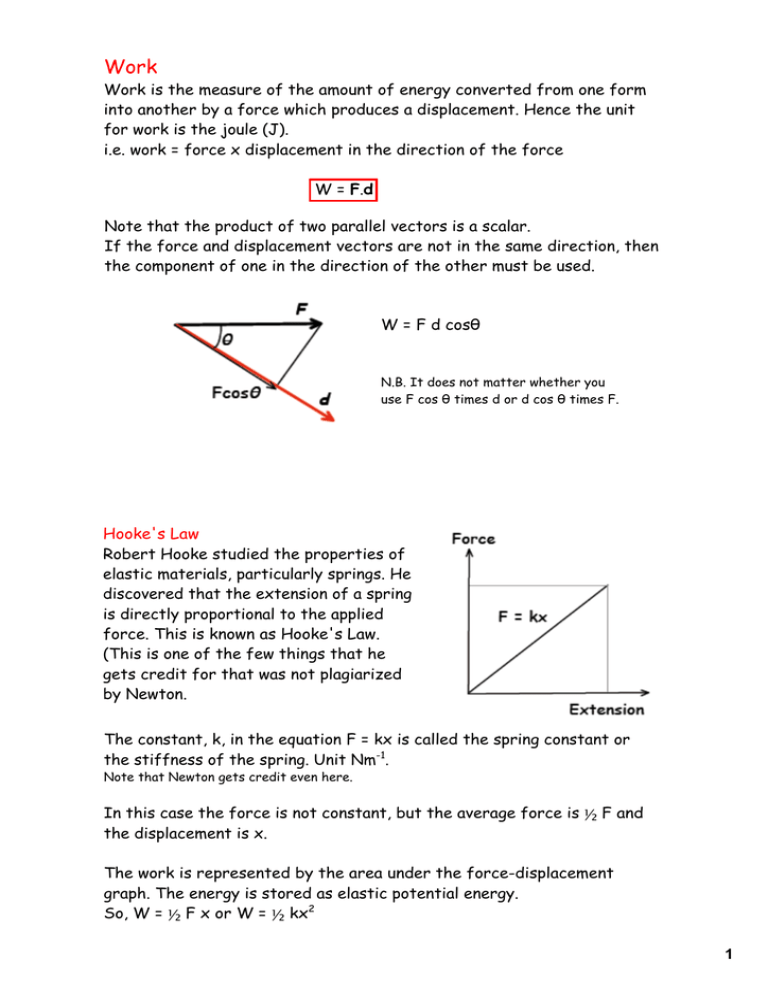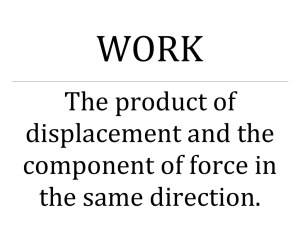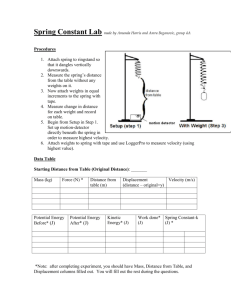1 Work is the measure of the amount of energy converted from one
advertisement

Work Work is the measure of the amount of energy converted from one form into another by a force which produces a displacement. Hence the unit for work is the joule (J). i.e. work = force x displacement in the direction of the force W = F.d Note that the product of two parallel vectors is a scalar. If the force and displacement vectors are not in the same direction, then the component of one in the direction of the other must be used. W = F d cosθ N.B. It does not matter whether you use F cos θ times d or d cos θ times F. Hooke's Law Robert Hooke studied the properties of elastic materials, particularly springs. He discovered that the extension of a spring is directly proportional to the applied force. This is known as Hooke's Law. (This is one of the few things that he gets credit for that was not plagiarized by Newton. The constant, k, in the equation F = kx is called the spring constant or the stiffness of the spring. Unit Nm-1. Note that Newton gets credit even here. In this case the force is not constant, but the average force is ½ F and the displacement is x. The work is represented by the area under the force-displacement graph. The energy is stored as elastic potential energy. So, W = ½ F x or W = ½ kx2 1 Kinetic Energy A body in motion has kinetic energy. Translational, rotational and vibrational kinetic energy are all forms of kinetic energy. Consider a steady force causing a body of mass m to accelerate from rest to a velocity v, and therefore giving it translational kinetic energy. v2 = u2 + 2as v2 = 2as v2 = 2Fs/m but u = 0 so but a = F/m so but Fs = work done Work done = EK = ½mv2 Gravitational Potential Energy If two bodies exert an attractive force on each other, then work must be done to separate them. This change in position relative to the other produces a change in potential energy. If they are released, the attractive force will convert this stored energy into kinetic energy as they accelerate towards each other. Consider a mass, m lifted a height Δh from the earth's surface. The lifting force necessary is equal to the weight of the object. Work = force . displacement = mg . Δh Gravitational Potential Energy E = mgΔh 2 Conservation of Energy The principal of Conservation of Energy states that: "The total energy of the universe is constant" or "Energy can be neither created nor destroyed; only changed from one form into another." If we are dealing with a system smaller than the whole universe, then energy will be conserved as long as there is no net transfer of energy into or out of the system. In that case, the gain of one type of energy must balance the loss of another type of energy. An important consideration is whether there is a friction force doing work converting energy into heat energy. If you are told to "ignore air resistance" or that a surface is "smooth", meaning frictionless, then this can be ignored in a problem. Elastic and inelastic collisions In a collision, momentum is conserved. Kinetic energy may be conserved, in which case the collision is described as "elastic". Kinetic energy is not conserved in an "inelastic" collision. In that case, work is done compressing the colliding objects, or the ground, producing other forms of energy. A collision may trigger a release of chemical or elastic energy. Power Power is defined as the rate of energy conversion or the rate at which work is done. Power = work done / time taken P = ΔW/Δt -1 Unit: watt (W = Js ) Efficiency When energy is converted from one form to another, some of the energy is usually converted to heat by the forces of friction. This is essentially a non-useful form of energy. The efficiency of an energy conversion process is a measure of the proportion of energy converted into the desired useful form. It is usually expressed as a percentage. Efficiency = Useful energy output x 100% Energy input 3



